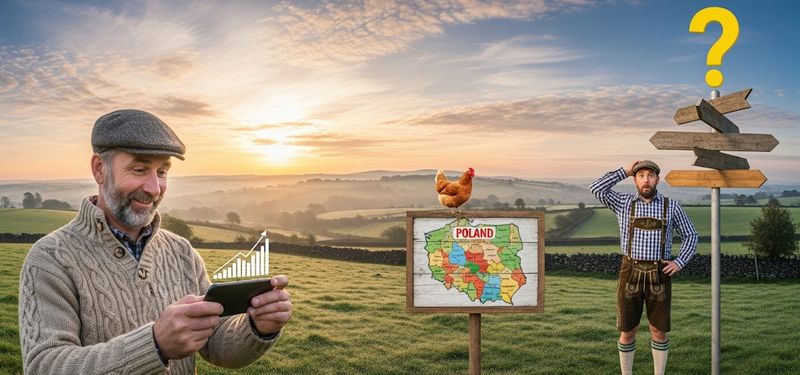
Published in News
Market Pulse: Irish Export Value Soars, Poland's Poultry Boom, and German Label Review
Irish beef exports get a value boost, Polish poultry floods the EU market, and Germany rethinks its complex animal welfare labelling scheme

Bo Pedersen
Chief Revenue Officer
A surge in export values for key producers and a major regulatory rethink in Europe's largest market are the dominant themes this week. We break down the latest news on Ireland's booming beef exports, Poland's continued poultry expansion, and Germany's decision to review its flagship animal welfare label.
International Trade: Value of Irish Beef Exports Jumps 12%
What happened: New figures from Bord Bia (the Irish Food Board) show that the total value of Irish beef exports for the year to date has increased by 12% compared to the same period in 2024. The growth has been driven by a combination of firm prices and strong demand from key EU markets, alongside a significant increase in volumes to newly opened markets in Asia.
Why it matters: This is a significant success for the Irish beef sector, demonstrating its ability to capture value and diversify its markets. As we noted in our report on August 20th, the recent awarding of PGI status for 'Irish Grass Fed Beef' is a key part of this strategy, allowing exporters to build a premium brand identity and command higher prices. This value growth is crucial for offsetting high on-farm input costs.
Implications & suggested actions:
Irish Farmers & Processors: The strong export value is a direct return on the industry's investment in quality, sustainability, and marketing. Continue to leverage the PGI status in all customer conversations to reinforce this premium positioning.
EU Competitors: Ireland's success in adding value through a protected geographical indicator is a powerful case study. It highlights the need to move beyond commodity trading and focus on your own unique regional or national production stories to compete effectively.
Wholesalers & Retailers: The strong brand identity of Irish beef, now backed by a PGI, makes it an attractive proposition for consumers. Use this clear provenance story in your marketing to justify the price point and build customer trust.
Market Trends: Poland Reports Record Poultry Exports to Western EU
What happened: Poland's National Poultry Council has reported a record month for poultry exports in July 2025, with volumes up 15% year-on-year. The most significant growth was seen in sales to other EU member states, particularly Germany and the Netherlands. The Council attributed the performance to the Polish sector's cost-competitiveness and its ability to fill supply gaps left by regions previously impacted by Avian Influenza.
Why it matters: This data confirms Poland's growing dominance as the EU's poultry powerhouse. Its scale and cost-efficiency are putting significant competitive pressure on producers in higher-cost Western European countries. This trend is reshaping the supply map for poultry across the continent, making Polish products a mainstream feature in Western EU retail and food service.
Implications & suggested actions:
Poultry Farmers & Processors (Western EU): The competition from Poland is structural, not temporary. Focus on areas where you have a competitive advantage, such as local sourcing schemes, higher welfare standards, or specific breed attributes, to differentiate your products.
Wholesalers & Buyers: Poland offers a reliable source of large volumes of competitively priced poultry. This is a key opportunity to manage your input costs, but it is also important to maintain a diverse sourcing portfolio to mitigate any future risks.
Logistics & Haulage: The increasing flow of poultry from East to West is creating new opportunities for refrigerated transport operators who can offer efficient and reliable services on these key trade routes.
German Regulation: Government to Review Animal Welfare Labelling Scheme
What happened: Germany’s Federal Ministry of Food and Agriculture has announced it will launch a formal review of its national "Haltungsform" animal welfare labelling scheme. The review comes in response to criticism from both consumer groups, who find the five-tier system too complex, and farmer unions, who argue that the scheme is not delivering sufficient financial returns for producers who invest in the higher-welfare tiers.
Why it matters: The Haltungsform scheme has been a key driver of welfare standards in Europe's largest meat market. Any significant change to the system will have major implications for the entire supply chain, from farm to retail. A move to a simpler, more impactful system could accelerate the transition to higher welfare, but it also creates a period of uncertainty for producers and exporters who have invested heavily in meeting the current standards.
Implications & suggested actions:
German Farmers & Processors: Engage actively in the review process through your industry associations. This is a critical opportunity to shape a future system that is both understandable for consumers and, crucially, economically viable for producers.
EU Exporters to Germany: This is a key development to watch. The outcome of this review will directly impact the standards you need to meet to access the German market. Monitor the process closely and be prepared to adapt your production systems accordingly.
Retailers: As we reported on August 20th, major retailers like Lidl are already accelerating their own welfare targets based on the current Haltungsform tiers. This government review may require you to adapt your own-label branding and consumer communication strategies in the near future.
Sources
Irish beef export value up 12% in year to date - Bord Bia (26 August 2025)
Poland's poultry exports hit new record in July - Polish National Poultry Council (26 August 2025)
German government announces review of Haltungsform animal welfare label - BMEL (Federal Ministry of Food and Agriculture) (25 August 2025)
